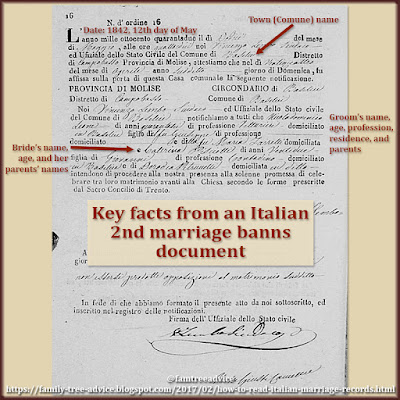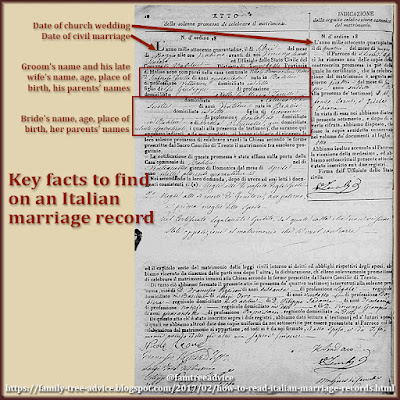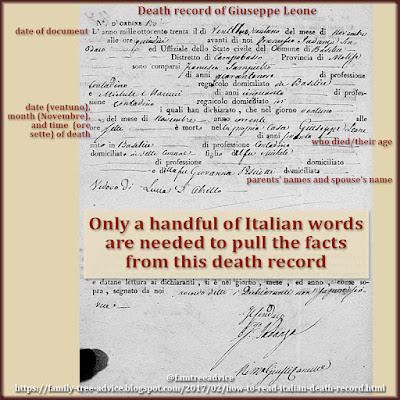THIS ARTICLE HAS BEEN COMPLETELY REVISED AND UPDATED! See https://family-tree-advice.blogspot.com/2024/11/italian-marriage-records.html
When I was documenting every birth, marriage and death record from the Italian town of Baselice between 1809 and 1860, I was thrilled with the massive amount of information you could glean from marriage documents. In this town there was a whole packet of papers about the wedding itself. But if, say, the groom's father was dead, you would also get his death record. And if his father was also dead, you'd get his death record, which includes the name of his parents. So suddenly you've gone back three generations from the groom.
During this period of time a couple had to publicly post a notification of their intent to marry—twice—usually one or two weeks apart. These two posting dates were recorded by the town. After that an official document gave them the ability to be married.
Then the couple was married in the local church. The town would have one record for the first banns, another for the second, and another for the marriage.
Here are examples using my great great great grandfather Nicoladomenico Leone's second marriage to my great great great grandmother Caterina Pisciotti. (She was almost the same age as his eldest daughter!)
 |
| First notification of intention to marry |
 |
| Second notification of intention to marry |
The year 1842 the 12th day of the month of May at 2 p.m., I, Vincenzo Lembo mayor and official of the Comune of Basélice, District of Campobasso, Provine of Molise, testify that on the 24th day of April in this same year, a Sunday, was affixed on the door of this town hall the following notification. … Nicoladomenico Leone, age 43 (I have not figured out what the occupation says) who lives in Basélice, son of the late Giuseppe and the late Maria Zarelli, and Caterina Pisciotti, age 22, daughter of Giovanni, a farmer in Basélice, and Dorodea Petruccelli, living in this town intend to enter into a solemn promise of marriage with this second notice. (That last part is not verbatim.)
When the couple is declared free to marry, another document is issued. The year 1842 the 16th day of the month of May at 9 p.m. … the same name and woman appeared before the same mayor, having twice posted their intention to marry, the second time on the 24th of April.
On the back of this document is a paragraph stating that the couple was married in the church on the fourth of June 1842. It includes the priest's name.
 |
| An Italian marriage record |
The above marriage document includes my great great great grandfather Nicola Leone's signature at the bottom. That's a treasure in itself. The document includes the dates of the posting of the couple's intentions, their church ceremony date on the right, and again their names, ages, occupations, and their parents' names.
In another post I show some of the other documents in what I call the wedding packets. See "The Italian Genealogy Goldmine: 'Wedding Packets'."

